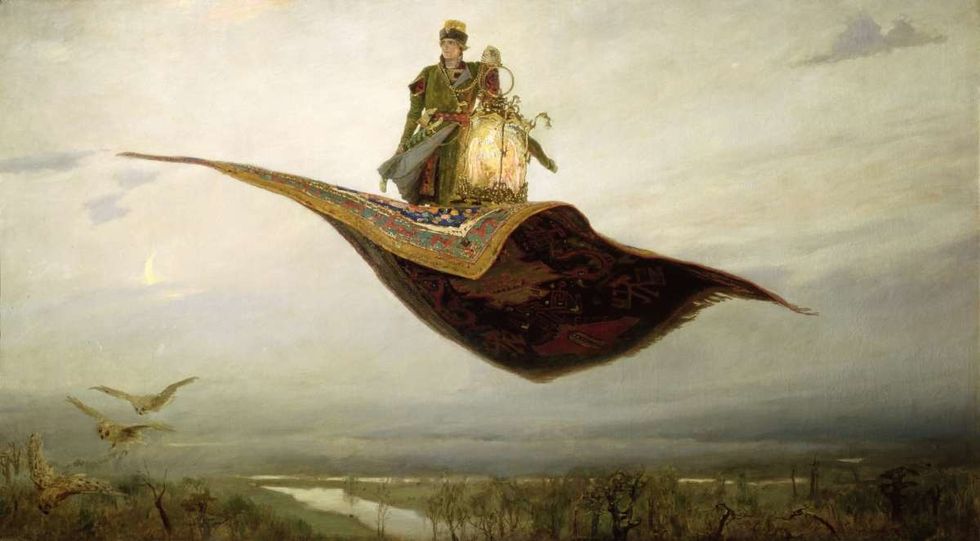Our senses often deceive us. Sight, sound, smell, taste, and touch gather information for our brains to interpret. When there's missing data, our brains fill in the gaps, creating scenarios that don't exist. This leads to optical illusions. Greek photographer Nontas Kalogiannis (@kalogiannis_epam) captured a stunning example of such an illusion, the “fata morgana,” which is now viral on social media, as reported by Daily Mail Online.
The surrealistic photograph displays The Achilleas, a giant freight ship, "floating" in the air like a cloud hovering above the sea. It was traveling on the shipping line between Greece's mainland at Kimi and Skiros. The vessel appears like a “flying saucer” or a “phantom ship,” deceiving to the eye.

A similar image was captured in 2022 by photographer Martin Stroud, which showed a large cargo ship near the small village of Coverack in Cornwall, England floating in the air, reported Independent. Even in 2020, a similar picture was snapped when Monika Schaffner, who was traveling through Mt Maunganui. She looked out over the ocean and saw what looked like a large object hovering in the sea. There are dozens and dozens of these photographs, but the phenomenon is just “fata morgana.”
Historian Marina Warner, in her book “Phantasmagoria,” describes fata morgana as “castles in the air.” This happens “when the minerals and salts in the region rise up in hot weather in vapors from the sea to form clouds, which then condense in the cooler upper air to become a mobile specchio, a moving, polyhedral mirror,” wrote Warner.

For centuries, sailors and landbubblers have been fascinated and equally haunted by these complex miragelike sightings. “Fata morgana” is an Italian term named after the Arthurian sorceress Morgan le Fay. These mirages were believed to be fairy castles in the air or false land conjured by her witchcraft to lure sailors to their deaths, explains SKYbrary.
Even more so, folklore states that this mirage was the reason for sightings of the Flying Dutchman, a 17th-century "ghost ship" doomed to sail the seas forever. Wired explained this as “basic physics.” When the sun heats up the atmosphere above the ocean, it creates a gradient of temperatures that forms an air-cake, in which a layer of warm air flutters atop a layer of cool air. When the light touches the boundary between the two layers, it bends and travels through the new layer at a different angle. This is known as refraction.

Followed by refraction, the rest of the illusion is triggered by how the brain works. When the brain receives the light that is bent, the brain thinks that the object is where it would be if the light's path was straight. In fata morgana, the brain places the object where it would be if the light traveled in a straight path, higher than it actually is. This creates the illusion that a ship is a lot more above the sea than it actually is.
A fata morgana might be observed anywhere, including land, mountains or sea. Photographer Kalogiannis has captured several photographs that depict this bizarre phenomenon. Here are some of them:





































 A pair of scissors.
A pair of scissors. A can opener opening a tin can.
A can opener opening a tin can. Jimi Hendrix playing on stage.Public Domain
Jimi Hendrix playing on stage.Public Domain A man handing over $20 in cash.
A man handing over $20 in cash. A person using a power saw.
A person using a power saw.
 Rock deterioration has damaged some of the inscriptions, but they remain visible. Renan Rodrigues Chandu and Pedro Arcanjo José Feitosa, and the Casa Grande boys
Rock deterioration has damaged some of the inscriptions, but they remain visible. Renan Rodrigues Chandu and Pedro Arcanjo José Feitosa, and the Casa Grande boys The Serrote do Letreiro site continues to provide rich insights into ancient life.
The Serrote do Letreiro site continues to provide rich insights into ancient life.




 Music isn't just good for social bonding.Photo credit: Canva
Music isn't just good for social bonding.Photo credit: Canva Our genes may influence our love of music more than we realize.Photo credit: Canva
Our genes may influence our love of music more than we realize.Photo credit: Canva